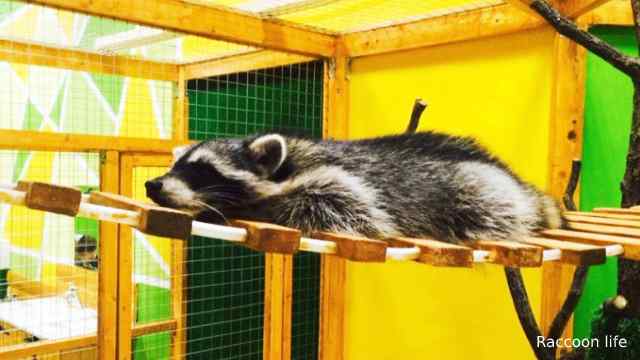Can I keep a raccoon enclosure in the apartment? So let us discuss in detail how to build a cage for a raccoon with your own hands.
The raccoon enclosure is not intended for the permanent residence of the raccoon. The protective structure serves the weasel only for sleeping and in case there is no one to watch over the masked predator. That is, the cage for the raccoon will save the apartment and the pet itself from irreparable damage.
 |
| Raccoon Enclosure in The Apartment |
Determination of the Location of the Raccoon Cage
Experts recommend that you build an aviary in a place that is suitable for keeping a raccoon. The cage should not be placed in the living room or bedroom. The home should have reliable cable protection. That is, there should be no loose wires on the floor or hanging on the wall.
There are many cases when the raccoons' excessive curiosity tempts them to nibble on the live wires. The result of such pranks is inevitable. The raccoon gets a fatal electric shock.
The room where you plan to place the raccoon enclosure should not contain valuable furniture or expensive decorations, among other things. Raccoons are overly energetic and play with furnishings.
The raccoon can chew on furniture corners, it can hang on the chandelier and tear off wall paintings.
Knowledgeable raccoon owners set up play areas in the room for their animals. Such facilities include all kinds of ladders, steps, scaffolding, and other "throwing objects" that help dissipate excess energy before a meal or nap.
DIY Raccoon Enclosure: Design and Materials
Raccoon enclosure size
Once the location of the raccoon enclosure in the apartment is determined, you can start building the cage. As for the dimensions, the raccoon's habitat should not be too narrow. Many raccoon owners determine the height of the aviary from floor to ceiling. As a rule, the length and width of the cage is 1500x1500 (mm).
For the walls, it is best to use a purchased mesh with a maximum mesh size of 30 (mm). Make sure that one of the walls is covered with natural wood. You can use facing boards or ordinary wooden boards for this purpose. The wood should be placed over a grid because the raccoon with his striped tail can gnaw out a segment of the board and get out when no one is at home.
Material on the topic: Are raccoons dangerous to humans and pets?
The cage for a raccoon should also have securely closing doors. Do not limit yourself to a flap that can be closed with a latch. Raccoons are excellent at opening the most complicated locking mechanisms. Keep the key for the lock away from the raccoon. The window sash can be made from the same mesh. Of course, the perimeter of the door should be reinforced to prevent the raccoon from bending the edges of the door and penetrating its weak point. The flap should be hung on the usual door hinges.
As a base, it is better to use a rubber mat, which is easy to clean and dries quickly. Do not buy the cheapest mat. Raccoons are extremely sensitive to odors, so the smell of phenol can make your pet faint. The same goes for wood paneling on one of the walls. Do not buy pine or other spruce. Raccoons cannot stand the smell of pine. In a raccoon enclosure is better to use a lining of:
- Alder
- Oak
- Hazel
It is best to reinforce the cage with angle steel. The frame must be fixed to the floor, walls and ceiling. If the apartment has an expensive hardwood/laminate floor and a suspended ceiling, you can limit yourself to fixing the aviary to the wall. It is best to use a corner to attach the cage to several walls at once.


تعليقات
إرسال تعليق